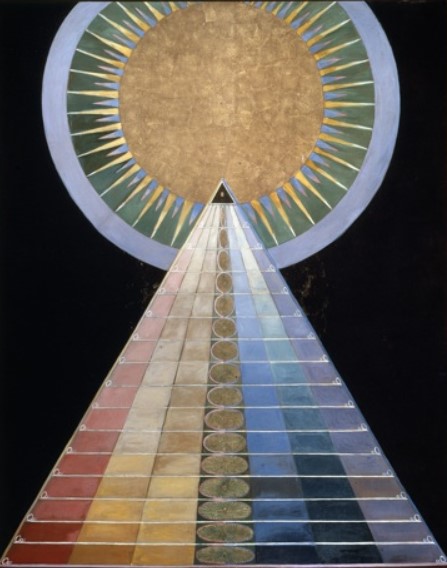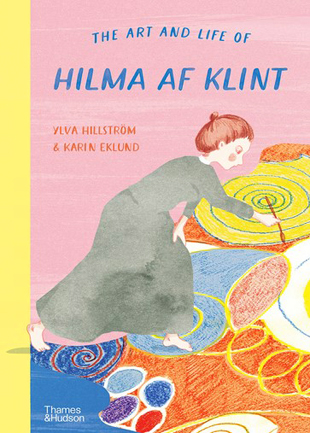How can a person be brilliant, creative, insightful, and fascinating, yet be almost lost to history? It happens more than we realize, often to women. Fortunately, Hilma af Klint was not one of the forgotten ones — but she came close.
Born in Sweden in 1862, af Klint's life was "filled with magic and mystery." She studied art at the Royal Swedish Academy of Fine Arts in Stockholm, where she was subject to remarks like "women shouldn't be allowed to paint at all." She only shook her head and kept on painting.
She saw beyond physical realms, often in uncanny ways. When her sister Hermina died, af Klint heard a soft voice calling her name. Once she realized whose voice it was, she wasn't surprised: "It felt as though she was close by, perhaps standing behind a curtain." Karin Eklund's illustration shows af Klint turning to look at her shadow — an extension of her long blue shirt — within which sits a silhouette of her sister, looking back at her.
Author Ylva Hillström, a curator at the Modern Art Museum in Stockholm, gracefully weaves together af Klint's spirituality and art. She also intersperses biographical stories with relevant historical developments: pages devoted to alchemy, theosophy, scientific discovers, and more. The book includes many full-page reproductions of af Klint's works. There's even a fold-out center portion featuring the three parts of her Altarpiece series, plus a key to the symbols' meanings.

Altarpiece No. 1, Group X (1915) by Hilma af Klint
The most astonishing and infuriating passage in the book was when Rudolph Steiner — the Austrian philosopher and social reformer in whose work Waldorf education is rooted — came to see af Klint's work at her invitation. His dismissive reaction left her feeling that no one understood her work, and she stopped painting for a period of time.
She knew how to reinspire herself, though, and started studying various religions and myths, many of which were about quests. This time away from painting only made her work stronger once she again picked up her brushes.
By the time af Klint approached death, practically no one had seen her pictures, more than a thousand of them. She asked her nephew Erik to take care of them, prophetically adding, "No one must see them until I've been dead for twenty years." He kept his word, and more than 20 years passed before he brought out her paintings. Now "hundreds of thousands of people visit museums around the world" to see them and "everyone is amazed."
Although this book is labeled as right for readers ages four through eight, my husband asked to read it when I was done, and he's in his sixties. The details alone are astonishing (did you know it took hundreds of eggs for af Klint to make the paints she used?), and her art ... well, if you haven't seen it, take a look. Who wouldn't want a book full of art like that and tales of the inspired life behind it all?
